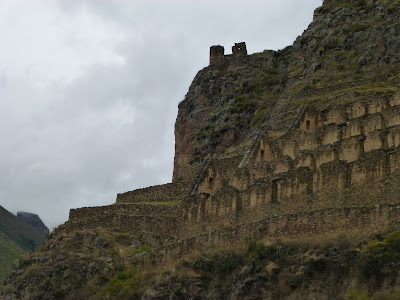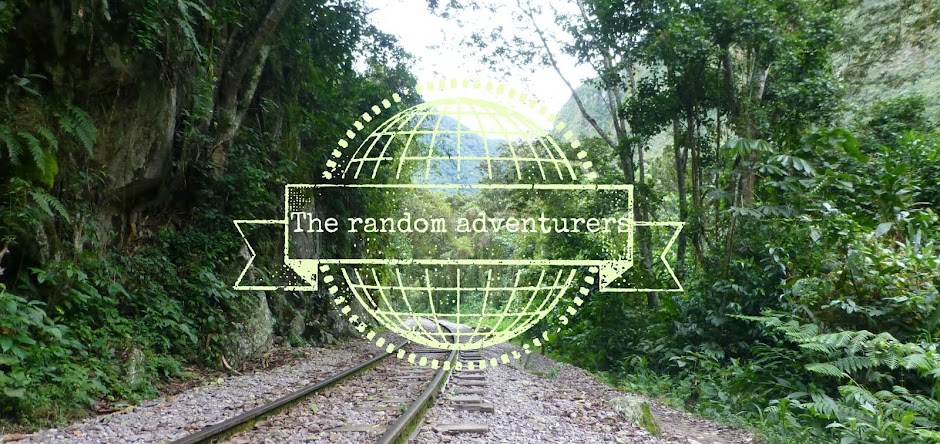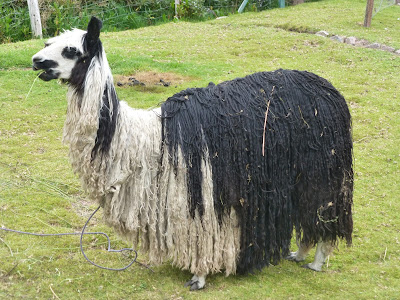 |
In every corner of Cuzco's city centre there's a tour operator yelling about how much they want to take you to Machu Picchu.
Of course by the time we made it to Cuzco, we had already read, asked, googled and guessed all we could about the visit to the ruins.
The uphill road to MP starts in Machu Picchu Pueblo, a town also known as Aguas Calientes, that can't be accessed by car or bus.
To get there, many people do the "Inca trail", a multiday hike through beautiful surroundings, heaps of walking... and guides and porters to carry your things and cook for you.
As nice and tempting as that must be for many people, we found it extremely non-random (and a bit expensive... and a bit too crowded).
One other option is the train. Expensive, beautiful (we love trains... especially Chey, who has way more train expertise than I do), and comfortable.
And the other option is getting to the small town of Ollantaytambo, take a bus from there to a hydro-powered dam ( referred to as Hidroeléctrica), and walk your way to Aguas Calientes using the train tracks as a path.
Cheap, with the promise of a lot of nice scenery, and definitely the randomest way to get to MP we could think of: it was definitely the winning option.
So we took a local bus going from Cusco to Ollantaytambo, and spent two nice days strolling around the cobblestone streets of the little town.
 |
| Chey exploring. |
 |
| Chey realizes I'm taking photos of him and reacts in a way that proves we're not sick of fame and chased by paparazzis (yet), |
Ollantaytambo is a very, very tiny valley. When you're in the "centre" you can see two sets of ruins, on both sides of the valley.
The first one is low: a set of pretty green terraces carved off the skirts of a mountain.
 |
| Imagine the hard work. |
The other set of ruins is uphill: many ancient buildings that seem like they're fading into the brown rocks of the hills.
 |
| Like an indigenous ghost town. |
We asked around and funnily enough the easily accessible terrace ruins that were constantly flooded with people were the ones you had to pay to enter. The old buildings up the hill are free to go to.
A MYSTERY! Maybe it is because most people pass through this town quickly on the way to MP and don't really want to waste time climbing?
Of course, we decided to go to the free of charge and non crowded ruins (surprised?).
At the beginning of the hike up, we found this friendly sign:
 |
| The blue one says: Attention: the way to Pinkuylluna is HIGH RISK (drawing of a skull) Don't go up (visit 7:00 to 5:30) The red one says visiting hours 7:00 to 4:30 PM. |
 |
| The stairs to get out of the town and into the proper hill. |
 |
| Hiking gear, TRA style: jeans and glasses, |
 |
| We did get a pretty cool view of the terraces in front of us without the need to endure all of the other tourists. |
 |
| From higher up, you also get a privileged view on the little details of the everyday life in Ollanta. |
 |
| There was a festival going on, and all the way up the hill we could hear the drums and the brass instruments. |
 |
| A closer view of the indigenous ghost town. |
 |
| And there is more! |
 |
| Chey walks to the ruins, |
 |
| We may or may not have spent a ridiculous amount of time playing in the buildings and climbing the windows. |
 |
| Sitting like a happy Gollum. |
 |
| A room with a view. |
 |
| Chilling while Chey tried different angles on the landscape. |
 |
| Detail of plants we found. |
 |
| And more. |
 |
| And more (alien looking lichen) |
 |
| Laugh in the face of danger (?) |
 |
| Black and white epic. |
Finally our curiosity was satisfied and we started the hike back, as it started to rain.
We settled ourselves at the warm and cozy "Hearts café" to dry and warm ourselves up with coffee and French toasts, rather than going back to our cold, cold room.
They have gorgeous food and really nice coffee. We even found an Aussie lady who was in love with their coffee, so that's saying something.
...
The second day, after unsuccesfully trying to have a not-freezing shower at our hostal, we decided we were going to try a different coffee place, since we already had 3 meals at Hearts café.
There are quite a few places arount the central Plaza, but we encountered the same thing as in many other places: targeting the tourists, all of the places offer the exact same thing.
We finally settled for a little place where we saw a couple of special combos for breakfast.
One of the combos was eggs on toast and black coffee.
Somewhere along the manu, they also offered capuccino.
However, there was no way of convincing the waiter that we wanted eggs on toast and capuccino, and we were willing to pay for the difference of adding milk to the black coffee.
He told us we could ONLY have eggs on toast if we had black coffee.
We ended up going to Hearts café again, of course.
...
The rest of our day in Ollantaytambo was spent arranging our transport to the starting point of the walk to Machu Picchu; and then walking, looking at the market and the river and the interesting locals. Afterwards, we tried to go to bed early-ish.
We had a long, long day ahead of us.
 |
| Little girl and tabby cat, cuddling. |
 |
| All of the narrow side streets look like this. |
 |
| A little door. |
 |
| Tabby cat camouflages with her environment. |
 |
| Romantic colonial sepia stuff. |
  |
| The river on one side of the town. |
 |
| Coffee time by the river (not Hearts café: the coffee was nice but lukewarm) |
 |
| This is the convenience store of the town, FOR REAL. |








































